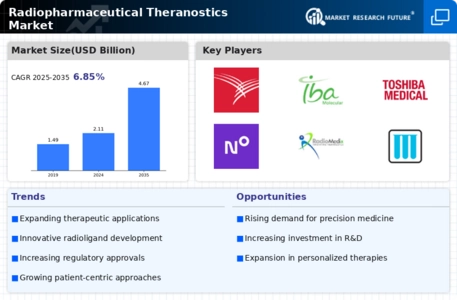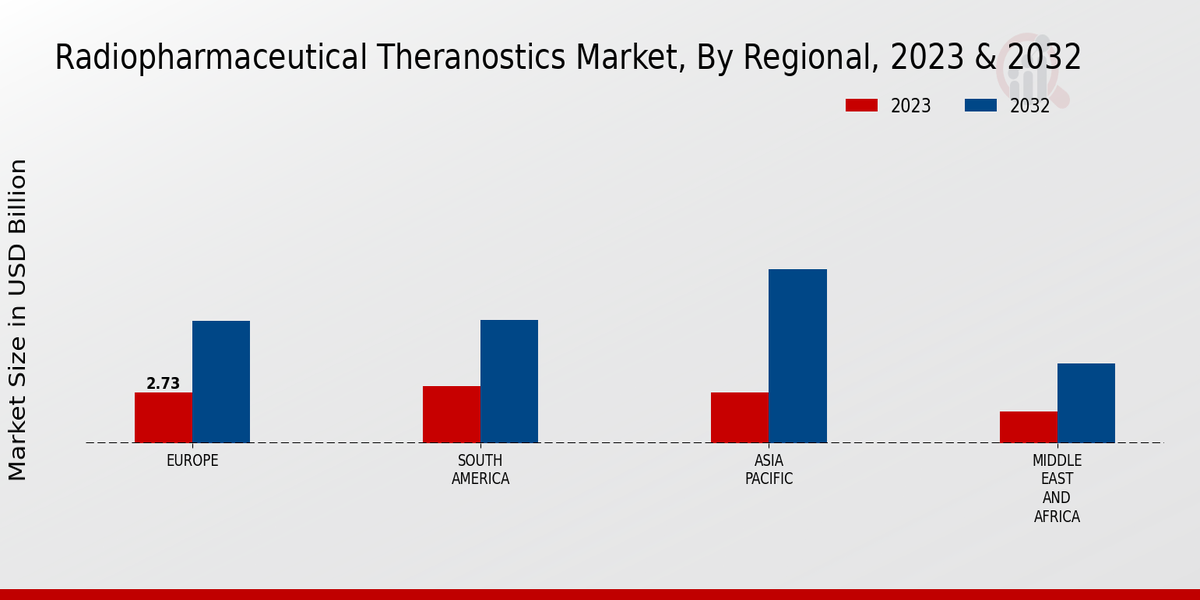Market Growth Projections
The Global Radiopharmaceutical Theranostics Market Industry is projected to experience substantial growth, with estimates indicating a rise from 2.11 USD Billion in 2024 to 4.67 USD Billion by 2035. This growth trajectory suggests a compound annual growth rate of 7.49% from 2025 to 2035. Such projections highlight the increasing relevance of radiopharmaceuticals in modern healthcare, particularly in oncology. The anticipated expansion of the market underscores the potential for innovation and the development of new theranostic agents that could revolutionize cancer treatment and diagnosis.
Increasing Incidence of Cancer
The rising incidence of cancer globally is a primary driver for the Global Radiopharmaceutical Theranostics Market Industry. With cancer cases projected to reach 29.5 million by 2040, the demand for targeted therapies is escalating. Radiopharmaceuticals, which allow for both diagnosis and treatment, are becoming increasingly vital in oncology. This trend is underscored by the anticipated market growth from 2.11 USD Billion in 2024 to 4.67 USD Billion by 2035, reflecting a compound annual growth rate of 7.49% from 2025 to 2035. The integration of theranostics in cancer management is likely to enhance patient outcomes and optimize treatment protocols.
Regulatory Support and Approval
Regulatory bodies are playing a crucial role in shaping the Global Radiopharmaceutical Theranostics Market Industry through streamlined approval processes for new radiopharmaceuticals. The establishment of clear guidelines and frameworks for the development and commercialization of theranostic agents is fostering innovation and encouraging companies to invest in this sector. This supportive regulatory environment is likely to expedite the introduction of new products, thereby enhancing market growth. As more radiopharmaceuticals gain regulatory approval, the availability of effective treatment options for patients is expected to increase, further driving market demand.
Technological Advancements in Imaging
Technological innovations in imaging modalities are significantly influencing the Global Radiopharmaceutical Theranostics Market Industry. Enhanced imaging techniques, such as PET and SPECT, facilitate precise localization of tumors and enable personalized treatment plans. These advancements not only improve diagnostic accuracy but also enhance the efficacy of radiopharmaceuticals in theranostic applications. As imaging technologies evolve, they are expected to drive the adoption of radiopharmaceuticals, contributing to the market's growth trajectory. The increasing sophistication of imaging tools may lead to a more tailored approach in oncology, thereby fostering a more robust market environment.
Rising Awareness of Personalized Medicine
The growing awareness and acceptance of personalized medicine are significantly impacting the Global Radiopharmaceutical Theranostics Market Industry. Patients and healthcare providers are increasingly recognizing the benefits of tailored therapies that consider individual genetic profiles and disease characteristics. This shift towards personalized approaches in treatment is likely to enhance the adoption of theranostic agents, which provide both diagnostic and therapeutic capabilities. As the healthcare landscape evolves, the demand for personalized medicine is expected to rise, thereby contributing to the overall growth of the radiopharmaceutical market.
Growing Investment in Research and Development
The surge in investment for research and development within the field of radiopharmaceuticals is propelling the Global Radiopharmaceutical Theranostics Market Industry forward. Governments and private entities are increasingly funding initiatives aimed at discovering novel radiopharmaceutical agents and improving existing therapies. This influx of capital is likely to accelerate the development of innovative theranostic solutions, enhancing their application in clinical settings. As a result, the market is poised for expansion, with the potential for new products to enter the market, thereby increasing competition and offering more options for healthcare providers and patients alike.






















